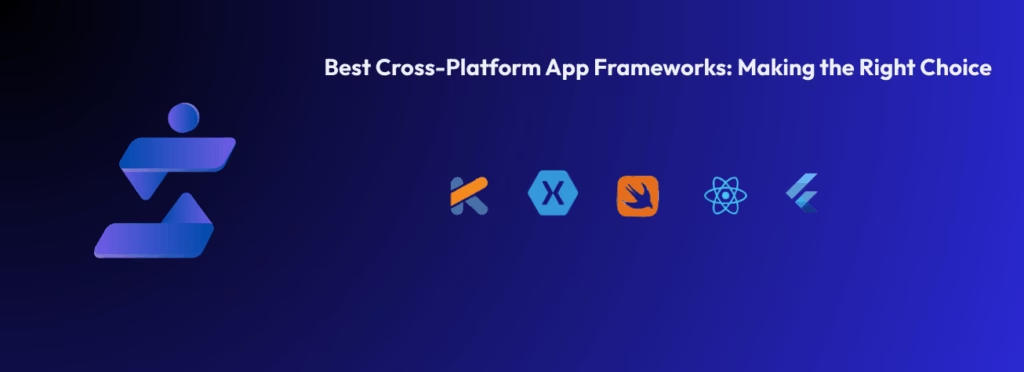Guide to the Best Cross-Platform App Frameworks: Making the Right Choice
Date August 23th, 2025 Author – Sisyphus Time to Read – 6 min Guide to the Best Cross-Platform App Frameworks: Making the Right Choice Conventionally, mobile app development has been a time-consuming and intricate endeavor. To accelerate this process and enhance efficiency, businesses are increasingly turning to cross-platform app development frameworks that offer greater flexibility and faster time-to-market. Conventional app development often follows a linear sequence of steps that can lead to bottlenecks and errors, causing project delays and escalating expenses. Each phase—conceptualization, design, development, testing, and deployment—requires meticulous attention to detail, making it crucial to adopt tools that simplify these processes without compromising quality. Selecting the right cross-platform framework allows companies to develop high-quality applications that work seamlessly across multiple operating systems. By maintaining a unified codebase for both iOS and Android, organizations can drastically cut down on redundant efforts, reduce maintenance overhead, and speed up updates and feature rollouts. These modern frameworks empower businesses to stay competitive by delivering reliable, performant mobile apps quickly while optimizing resource allocation and reducing total development costs. The Factors Fueling the Surge of Cross-Platform Development Frameworks in 2025 Creating separate native apps for iOS and Android demands a higher investment from businesses. This is due to the need to maintain two different codebases, employ multiple development teams, and put in double the effort for updates and feature releases. As a result, the mobile app development process becomes even more complex and resource-intensive. As a result, cross-platform mobile app development frameworks have gained traction by easing the workload on businesses in these ways: Single Codebase for All Platforms Write code once and deploy it everywhere. Using a shared codebase eliminates the necessity to create and maintain separate logic for each platform. Frameworks like Kotlin Multiplatform allow reuse of key components such as business logic and data management across various devices, reducing duplication and effort. Accelerated Development and Faster Market Launch Maintaining a single codebase accelerates development speed and can cut time-to-market by up to half. Features like Flutter’s Hot Reload and React Native’s Fast Refresh enable developers to see UI changes instantly, without needing to restart the app. Cost Savings Through Efficient Resource Utilization Managing distinct development teams for iOS and Android consumes substantial time and budget. With a unified codebase, a combined team can handle both platforms, optimizing technical resources and significantly lowering overall expenses. Scalable Solutions & Versatile Platform Support Today’s applications must perform seamlessly across mobile, web, desktop, and wearable devices. Cross-platform app development frameworks provide the versatility to support multiple platforms, establishing them as a forward-thinking option. Uniform User Experience Across Devices With solutions like Flutter’s Material and Cupertino widgets, there’s no need to question which framework fits best for iOS or Android – these widgets deliver a native-like look and feel on any operating system. Likewise, React Native facilitates smooth integration with native UI elements, ensuring users have a consistently high-quality experience regardless of the device. Let’s Connect Best 5 Cross-Platform App Development Frameworks At present, Flutter and React Native stand out as the leading choices for cross-platform mobile app development, consistently dominating this space. Let’s explore in depth what features and capabilities are fueling their rising adoption, as more organizations seek scalable and economical mobile solutions to meet industry demands. Flutter Flutter proves highly effective for delivering an experience that closely mirrors native apps while developing for multiple platforms. It grants seamless access to essential device capabilities such as camera integration, location tracking, and local storage. For any device-specific feature not inherently supported, developers can utilize Platform Channels to implement custom, platform-targeted code. Its flexibility has secured trust from 46% of developers globally, with leading companies such as Google Ads, Alibaba Xianyu, eBay Motors, and the Hamilton app opting for Flutter. Reasons to Select Flutter: Effortlessly reuse UI modules across different operating systems Accelerate MVP (Minimum Viable Product) creation for fast testing and validation Enhance speed and efficiency for applications demanding robust CPU/GPU capabilities Key Advantages: Enables instantaneous code updates with Hot Reload, streamlining development cycles Delivers uniform interface elements through Material and Cupertino widget libraries, guaranteeing consistent appearances across devices Utilizes a proprietary rendering engine for reliable, smooth cross-device performance Supports a wide array of platforms, covering iOS, Android, web, and desktop systems React Native If you’re focused on developing a lightweight and straightforward application, React Native is an excellent choice for building cross-platform apps. Launched by Facebook in 2015, React Native is a free framework designed for creating hybrid mobile applications using JavaScript. Building on the foundation of ReactJS, it lets developers use the same codebase for both Android and iOS, while still providing users with an experience that feels native. Reasons to Select React Native: Easily incorporate a wide range of third-party UI libraries to accelerate development cycles. Perfect fit for teams who are already skilled in JavaScript or React. Key Advantages: Fast Refresh enables real-time code modifications, streamlining the development workflow. Native elements deliver polished user interfaces and robust user experiences. Integrated debugging support with tools like Flipper makes troubleshooting more efficient. The framework benefits from a vibrant developer community, offering regular updates and strong technical assistance. Kotlin Kotlin stands out as a top choice for cross-platform app development when you want to share essential code while still delivering a native look and feel. Crafted by JetBrains, this tool lets you apply business logic to both Android and iOS, while giving you the option to work with each platform’s native UI frameworks for tailored user interfaces. It blends effortlessly with existing projects and has been increasingly adopted by major apps like Netflix, Cash App, and VMware, highlighting both its versatility and reliability. It blends effortlessly with existing projects and has been increasingly adopted by major apps like Netflix, Cash App, and VMware, highlighting both its versatility and reliability. Reasons to Select Kotlin: Transfer Kotlin code and expertise between mobile, web, desktop, and server applications Build authentic native interfaces using each platform’s dedicated tools Incorporates smoothly into current apps, so you avoid starting


